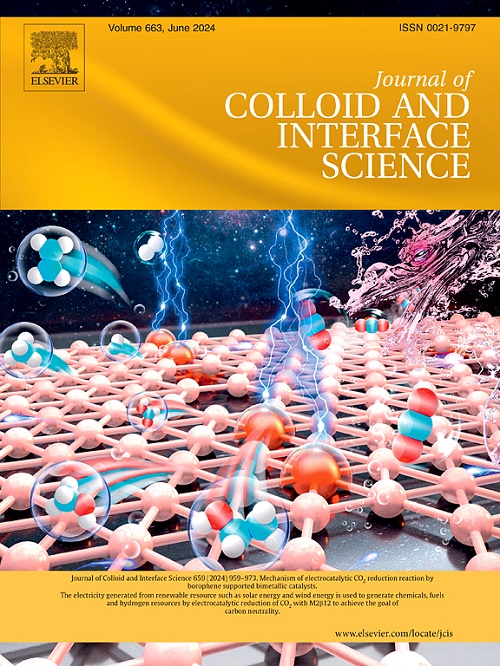通过低温热化学策略,通过高效的析氧反应衍生出高价镍氧氢氧化物
IF 9.7
1区 化学
Q1 CHEMISTRY, PHYSICAL
引用次数: 0
摘要
高价镍(铁)金属被认为是实用的电活性相,可以加速反应动力学,并在碱性析氧反应(OER)中表现出较高的固有反应活性。然而,它们的形成和稳定在热力学上是不利的。氧阴离子具有独特的聚阴离子基序和合适的电负性,使它们能够与邻近的金属阳离子共享更多的分散电子,从而平衡金属阳离子的强正电子场。与传统的金属阳离子或非金属阴离子修饰相比,这一特性提供了一种更有利的方法来调节表面自重构。在此基础上,本文提出了一种硫氧阴离子调节方法来获得稳定的高价Ni(Fe)相。通过在过硫酸铵和水的低温反应介质中对工业NiFe泡沫进行简单处理,可以将硫氧阴离子直接预锚定在Ni(Fe)氢氧海胆阵列催化剂上。预键合的硫化氧可以有效地调整电活性位点的电子能级(如氧化态工程、带隙缩小、金属- o共价和金属d带中心),从而改变表面电荷转移速率,进一步增强OER中间体的吸附、转化和解吸。最终,OER动力学得到加速,并且可以克服持久的*OH - *OOH标度关系,从而降低过电位。最终催化剂具有优异的OER性能,在10 mA cm - 2时过电位低至219 mV,动力学快速(54.1 mV/dec),耐用性为693 h,可保持100 mA cm - 2的初始电流密度。对简单的低温热化学氧化硫化物调制方案和硫酸盐调节在提高OER活性中的作用的信息见解可以拓宽对电催化中氧阴离子效应的理解,并为设计实际应用的尖端电催化剂提供合理的方法。本文章由计算机程序翻译,如有差异,请以英文原文为准。

High-valent nickel oxyhydroxides self-derived through a low-temperature thermochemical strategy for an efficient oxygen evolution reaction
High-valent Ni(Fe) metals are considered practical electroactive phases that can accelerate reaction kinetics and exhibit high inherent reactivity during the alkaline oxygen evolution reaction (OER). However, their formation and stabilisation are thermodynamically unfavourable. Oxyanions possess a unique polyanionic motif and suitable electronegativity, enabling them to share more dispersed electrons with adjacent metal cations and thereby balance the strong positive electronic fields of the metal cations. This characteristic offers a more favourable approach to modulate surface self-reconfiguration compared with conventional metal cation or non-metal anion modifications. Based on this, herein, an oxysulfide anion regulation method is proposed to obtain stable high-valent Ni(Fe) phases. The oxysulfide anion can be directly pre-anchored onto a Ni(Fe) oxyhydroxide sea-urchin array catalyst by simply treating the commercial NiFe foam in a low-temperature reaction medium of ammonium persulfate and water. The pre-bonded oxysulfide can effectively tailor the electronic energy level of electroactive sites (e.g. oxidation-state engineering, band gap narrowing, metal–O covalency and metal d-band centre), thereby altering the surface charge transfer rate to further enhance the adsorption, conversion and desorption of OER intermediates. Ultimately, the OER kinetics is accelerated, and the persistent *OH–*OOH scaling relationship can be overcome to reduce the overpotentials. The final catalyst achieves superior OER performance with a low overpotential of 219 mV at 10 mA cm−2, rapid kinetics (54.1 mV/dec) and prominent durability of >693 h to maintain the initial current density of 100 mA cm−2. Informative insights into both simple low-temperature thermochemical oxysulfide modulation protocol and sulfate-tuned roles in improving OER activity could broaden the understanding of the oxyanion effect in electrocatalysis and provide a rational approach for designing cutting-edge electrocatalysts for practical applications.
求助全文
通过发布文献求助,成功后即可免费获取论文全文。
去求助
来源期刊
CiteScore
16.10
自引率
7.10%
发文量
2568
审稿时长
2 months
期刊介绍:
The Journal of Colloid and Interface Science publishes original research findings on the fundamental principles of colloid and interface science, as well as innovative applications in various fields. The criteria for publication include impact, quality, novelty, and originality.
Emphasis:
The journal emphasizes fundamental scientific innovation within the following categories:
A.Colloidal Materials and Nanomaterials
B.Soft Colloidal and Self-Assembly Systems
C.Adsorption, Catalysis, and Electrochemistry
D.Interfacial Processes, Capillarity, and Wetting
E.Biomaterials and Nanomedicine
F.Energy Conversion and Storage, and Environmental Technologies

 求助内容:
求助内容: 应助结果提醒方式:
应助结果提醒方式:


